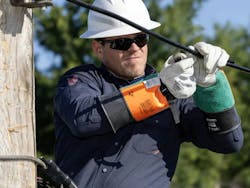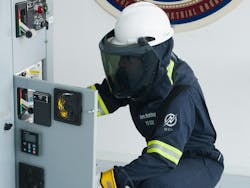Proper Maintenance and Replacement of Arc-Rated Personal Protective Equipment
In the electrical trade, the risks are not only highly consequential but can also come in an instant. Arc flash incidents, which occur when an electrical current deviates from its intended path and travels through ionized air, can produce temperatures exceeding 35,000°F — hotter than the sun’s surface. This is why anyone working on or near energized equipment must have the proper arc-rated (AR) protective clothing.
Until recently, however, more than 600,000 United States workers did not have proper personal protective equipment (PPE) to prevent injury from deadly arc flash hazards, according to the Occupational Safety and Health Administration (OSHA). This was primarily due to the dangerous myth that low voltage isn’t hazardous.
OSHA arc flash guidance update
In November 2024, OSHA released its first arc flash guidance update in almost 20 years. The guidance clarifies that low voltage (including 120V/208V) can sustain arc flash, produce molten metal, ignite flammable clothing, and cause severe or fatal injury. Before the update, most tasks claiming to be de-energized did not qualify as such, and workers performing those tasks did not have arc-rated clothing and other PPE.
The updated guidance emphasizes that almost all energized work requires PPE, including AR clothing. To obtain the arc-flash rating, PPE must be tested to see how well the material holds up against flash fires. All arc-rated clothing is inherently flame resistant (FR), but not all FR clothing has an arc rating. You may come across “arc flash clothing,” but it’s best to go with PPE with an arc-rating from a reputable brand. Below, we walk you through the best practices for maintaining AR PPE and how to determine when it’s time to replace it.
Understanding arc-rated PPE degradation
While AR clothing and PPE are designed to shield workers from the devastating heat, light, and pressure generated during arc flash events, they’re not immune to wear and tear. Over time, dirt, extreme temperatures, moisture, chemical exposure, and frequent use can degrade the flame-resistant and insulating properties of PPE, potentially creating conductive pathways that increase the risk of electrical hazards.
Even improper maintenance practices, such as washing with harsh detergents, using high heat during drying, or spraying disinfectants, can weaken fabrics and compromise their protective qualities, exposing workers to potential hazards.
Best practices for maintaining AR PPE
Arc flash gear, like most equipment, adheres to the age-old mantra: Take care of it, and it will take care of you. Thankfully, maintaining AR clothing is straightforward: Keep them clean, periodically inspect them for damage, and track how long they’ve been in active use.
Here’s a quick guide to maintaining your AR PPE so you can keep workers safe while maximizing your investments.
Laundering arc-rated clothing
Proper care for arc-rated clothing, including shirts, pants, coveralls, and suits, starts with following the manufacturer’s laundering instructions to preserve their flame-resistant properties.
Here are some general guidelines for washing AR clothing:
- When laundering AR clothing, gentler is always better. Doing so minimizes wear and tear and helps the gear last longer.
- Avoid using bleach, fabric softeners, or harsh detergents, as these can degrade the fabric. Instead, use a gentle detergent, and wash your items in lukewarm water, carefully avoiding high temperatures. Afterward, tumble dry them on a low heat setting.
- Remember to wash the PPE as soon as possible after being soiled. Always wash AR clothing before wearing it again, as dirty PPE is less effective and may heighten the risk of injury.
Laundering AR clothing is also a good opportunity to inspect the PPE. Look for rips, fraying, or worn areas, as even minor damage can compromise protection. When not in use, store them in a cool, dry environment to prevent exposure to moisture or UV radiation, which can weaken the material over time. Appropriate hangers allow the material to be in a relaxed position and kept free from creases that can weaken fabric over time.
AR gloves
Before every use, thoroughly inspect insulating AR gloves for punctures, tears, or any embedded debris. These specialized rubber gloves are made to exacting standards. We recommend air testing them to ensure safety, as even the tiniest pinhole can pose serious hazards. To perform an air test, close off the sleeve end to trap air inside and carefully roll the closed end downward toward the fingers. If no air escapes, the glove is intact and free of holes. If air leaks out, replace the gloves immediately.
After each use, wash the gloves with mild soap and water and dry them with a clean cloth. Always store them flat, away from sharp objects, chemicals, and heat sources to prevent deterioration. Finally, insulating gloves must undergo dielectric testing before their first use and be retested every six months while in service. According to OSHA standards (29 CFR 1910.137), gloves should also be tested after any repairs, if their insulating value is suspected to be compromised, or if they have been used without protectors.
AR face shields and hoods
Always inspect face shields and hoods for cracks, rips, discoloration, or other signs of wear before each use. Even minor damage can reduce their protective capabilities, so replace any compromised equipment immediately. To clean them, use a soft, non-abrasive cloth and a mild, non-alcohol-based cleaner to remove dirt, smudges, and debris. Avoid harsh chemicals or abrasive materials that could scratch or damage the surface, as scratches can reduce visibility and compromise protection.
Store face shields and hoods in a clean, dry place, away from direct sunlight, extreme temperatures, or chemicals. When not in use, use protective cases or pouches to prevent scratches and maintain their integrity.
AR boots and booties
Keep arc-rated boots free from dirt, oil, and other contaminants that could compromise their insulating properties. Use a damp cloth or mild soap to clean the surface, avoiding harsh chemicals that might degrade the material. While cleaning, inspect the boots for signs of wear, such as cracks, punctures, rips, or thinning soles. Pay special attention to the tread and seams, as these areas are prone to damage.
Visible damage, such as deep cuts, exposed stitching, or delamination of the sole, necessitates immediate replacement. If the protective toe cap is crushed or deformed or the footwear has been exposed to an arc flash incident, it should be retired, even if no visible damage is apparent. Otherwise, manufacturers often provide guidelines on the expected lifespan of their footwear.
Additionally, limit the use of arc-rated boots and booties to environments they are designed for. Avoid exposing them to conditions that exceed their protective capabilities, such as prolonged exposure to water or extreme heat. When not in use, store them in a cool, dry place away from direct sunlight, extreme temperatures, or chemicals. Avoid stacking heavy objects on top of them to prevent deformation.
Arc-rated PPE lifespan, replacement, and repairs
The lifespan of your arc-rated PPE depends on factors such as its construction, the materials used, and their usage frequency. While the manufacturer’s guidelines provide the most reliable information on a product’s lifespan, we recommend tracking the age of each item and how long it’s been in service. Any gear that is too old or worn out should be discarded, as it may no longer offer adequate protection. Additionally, garments exposed to a flash fire or other thermal events should be retired immediately, as their flame-resistant properties may be compromised.
However, certain types of damage can be repaired, offering a more cost-effective alternative to outright replacement. Manufacturers can provide guidance on whether repairs are possible and which ones are appropriate. In some cases, manufacturers may offer repair services.
Eventually, all PPE will need to be replaced. Invest in high-quality AR garments from reputable brands to maximize safety and value, and follow proper maintenance practices between uses. It’s paramount to ensure workers stay as safe as possible when performing dangerous and important work.
About the Author
Rick Pedley
Rick Pedley, PK Safety’s president and CEO, joined the family business in 1979. PK Safety, a supplier of occupational safety and personal protective equipment, has been operating since 1947 and takes OSHA, ANSI, PPE, and CSA work safety equipment seriously. For more information, visit www.pksafety.com.



